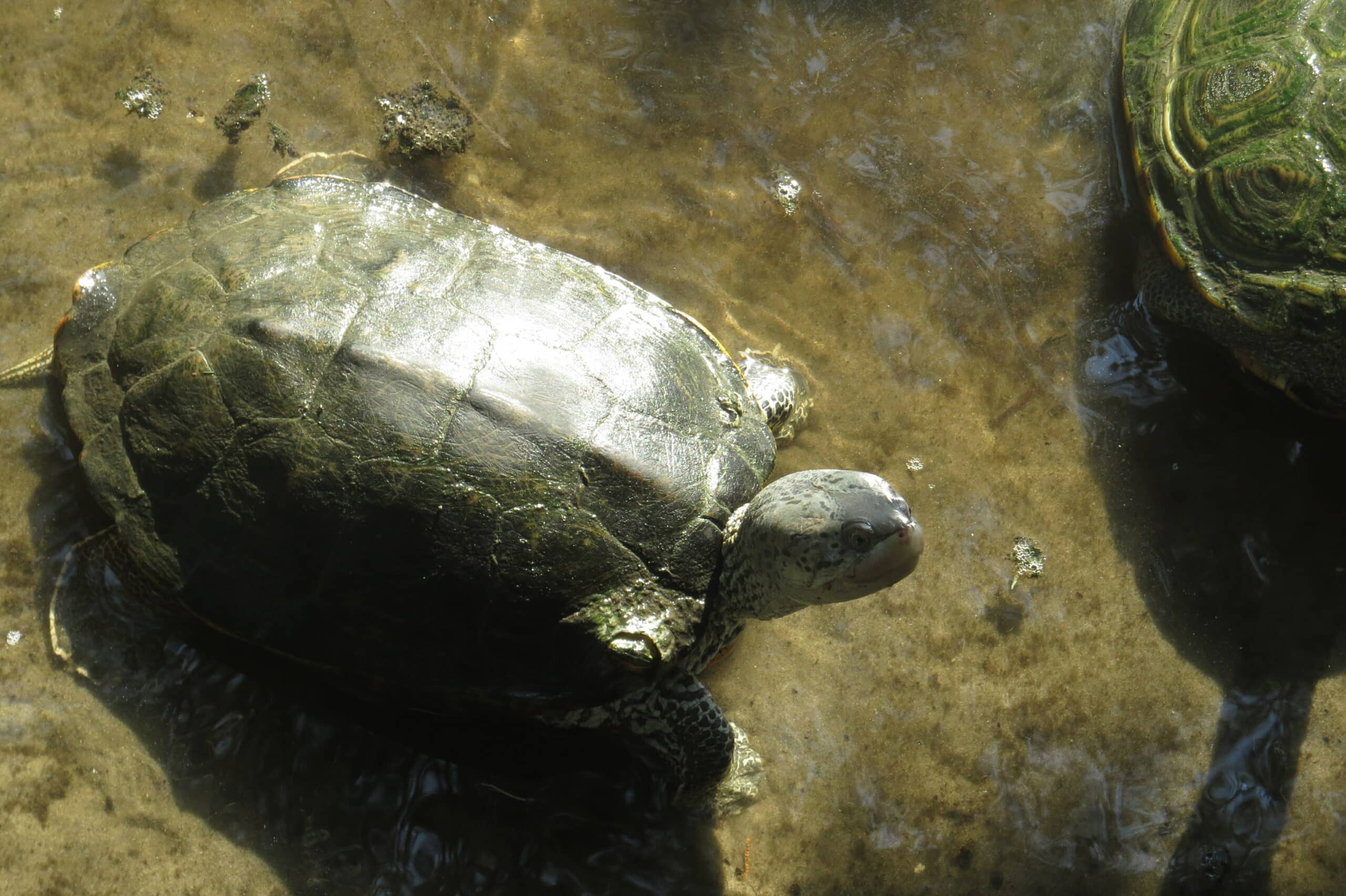
The diamondback terrapin, an estuarine turtle seen throughout much of the Outer Banks, has a special niche in the Atlantic coastal ecosystem, being the only turtle in the world that inhabits exclusively the brackish waters of estuaries, tidal creeks and salt marshes.
But islands such as Ocracoke may not be as welcoming to them as in the past due to a highly aggressive and invasive exotic plant that is eliminating much of their nesting habitat and putting their future at risk.
There may be a way to fend off this threat and help ensure long-term survival for this handsome turtle (Malaclemys terrapin) with its spotted face, striking colors and variable patterns on its shell, but action will be needed.
Terrapins have faced many obstacles to their existence over the centuries. In one case, it took a constitutional amendment to save them from extirpation.
In the latter decades of the 19th century, terrapin “turtle soup” became a popular and trendy gourmet item on menus at high-end restaurants, private clubs and even at the White House.
The demand for this perceived delicacy led to excessive harvesting, and nearly caused the species’ demise by 1920.
In a quirky twist of society’s mores, the 18th Amendment to the Constitution that banned the consumption of alcohol during the prohibition era, benefitted the terrapin.
How could teetotaling have had such an impact? The key ingredient in a decent terrapin soup or stew was sherry, which became a banned substance under the 18th Amendment, ratified in January 1919.
With restaurants unable to use this Spanish fortified wine in the recipe, the soup lost its pizzazz and disappeared from the menus. This ended the terrapin soup craze and harvesting became nearly nonexistent, allowing their drastically dwindled numbers to begin to increase. By the time the Amendment was repealed, culinary fads had moved on to other delicacies.
Although massive commercial harvesting is long gone, both legal and illegal wildlife trade as pets and food remain a problem and the terrapin has not fully recovered. It is listed both federally and in North Carolina and several other states as a species of Special Concern. The North Carolina Wildlife Action Plan considers it a priority species.
These days, in addition to trafficking, by-catch mortality from commercial and recreational crab pots, road crossing fatalities, pollution, sea level rise affecting coastal marshes and loss of habitat are the main causes of their premature deaths.
Unlike sea turtles, such as the loggerhead and the green turtle that spend their lives in the high seas with females only coming to land to lay eggs, terrapins stay close to shore in narrow Atlantic coastal estuarine habitats of tidal creeks and marshes.
Their range is from Cape Cod in the north, down to the coasts of Florida and along the Gulf Coast to Texas. Bermuda also has a terrapin population. With philopatric tendencies to remain in the same areas from where they hatched, terrapins do not make long-distance migrations. Females can lay two to three clutches of four to 24 eggs in late spring. The eggs usually hatch in 60 to 85 days, with hatchlings emerging from the nest in August and September. Sometimes hatchlings overwinter in the nest and emerge the following spring. During the cold winter months, they hibernate buried in the mud at the bottom of tidal creeks and marshes.
The bad guy: Phragmites in North America
Of the more than 5,000 invasive plant species embedded in North America’s ecosystems, Phragmites (Phragmites australis) is considered to be the most dominant and destructive. Also known as the Common Reed, it is highly aggressive and has many adverse effects on aquatic ecosystems, impacting native flora and fauna species. It is now found throughout the world, except for the continent of Antarctica.
The non-native Phragmites first appeared in North America in the late 18th or early 19th century, most likely brought over in ships from Europe, and has spread in wetlands throughout much of the continent.
Although there is a widely distributed but not very common North American native subspecies of Phragmites (americanus), it does not occur in the Southeast, which includes North Carolina. It is not the native subspecies but the invasive subspecies (australis) that is the problem for terrapins and which is found in abundance on Ocracoke.
Cassandra Cook cited many examples of this plant’s harmful effects in her College of William and Mary master’s thesis, “Impacts of Invasive Phragmites australis on Diamondback Terrapin Nesting.” Her research focused on Fisherman Island National Wildlife Refuge in Virginia.
Cook noted that Phragmites reduces marsh habitat quality for terrapins. Its presence has been linked to decreases in the abundance of smooth cordgrass (Spartina alterniflora), the aquatic plant found in brackish tidal marshes which hosts the marsh periwinkle (Littorina irrorata), a staple in the diamondback terrapin diet. Less cordgrass means fewer periwinkles for the terrapins to eat, thus making their foraging even more difficult.
Thick stands of Phragmites create an additional problem by lowering surrounding soil temperatures that can also jeopardize terrapins. The reason is that, like many turtle species, terrapins have temperature-dependent sex determination, meaning that the sex of hatchlings is the result of incubation temperatures. Cook found that a Phragmites cover of greater than 50% causes a decrease in incubation temperatures of terrapin nests sufficient to produce predominantly male hatchlings. Fewer females mean fewer hatchings.

It is easy to identify Phragmites by its height, which can be up to 15 feet. It has long, thin, green leaves and a large purple-brown flower head that turn silver in the fall. Despite its striking appearance, the scary part is subterranean.
Its rhizome stem system creates a root structure that can grow up to 60 feet in length at a depth of more than six feet. It spreads very efficiently, with new stalks growing off the roots. New locations can be infected through wind dispersal of its seeds.
In the spring, female terrapins look for sparsely vegetated sandy areas above the tide line to lay their eggs. When Phragmites invades these open areas and takes root, the nest site is no longer viable. The plant also spreads rapidly right up to the waterline. This high density creates an impenetrable hedge that prevents terrapins from easily finding a suitable nesting site.
As their habitat diminishes, terrapins must travel longer distances to find a site to lay their eggs. Early one morning a few years ago, I saw one attempting to lay her eggs in the middle of the sandy, busy Southpoint Road on Ocracoke.
The longer terrapins search for a suitable nesting site on land, the more vulnerable they are to predation. Later, an even worse danger occurs for the hatchlings which are exposed for much longer periods on their long, dangerous maiden trek to a marsh or tidal creek. This makes them easy pickings for ghost crabs, gulls, crows, raccoons, and other predators.

Large-scale Phragmites removal can be a bottomless money pit and, once the plant is firmly rooted almost impossible to completely eradicate. It is much easier to remove, or at least control, when detected in its early stages.
One feasible solution is a selective small-scale Phragmites eradication process in areas where terrapins would most likely nest near water.
Cook agreed that a Phragmites eradication effort could be effective. “Open it up and they will find it,” she said, noting that terrapins have nested on clear, sparsely vegetated dredge spoil islands.
Ron Emens also thinks this is doable. “I’ve been pushing for more Phragmites management, just in general in North Carolina because I’ve seen what it does in states like Maryland, New Jersey and Virginia,” he said in an interview.
Emens, the Aquatic Weed Program manager with the state’s Division of Water Resources in the N.C. Department of Environmental Quality, assists local governments and other stakeholders with the removal of aquatic weed infestations.
Two herbicides, glyphosate and imazapyr, can control Phragmites effectively when used individually or in combination. Careful use of these chemicals is vital to protect nearby native plants. Controlled burning and mechanical plant removal using small mowers, weed whips and brush hogs can be combined with these chemical applications.
By the time Phragmites has been removed or greatly diminished, the chemicals are long gone, Emens said.
Unlike sea turtles, the National Park Service and the U.S. Fish and Wildlife Service currently do not track diamondback terrapins, according to their officials. These two federal services, in partnership with many federal and state agencies, nongovernmental organizations, and hundreds of volunteers, have made remarkable progress increasing the number of nesting sea turtles, especially loggerheads, on the Outer Banks in the past 15 years.
Fortunately, there is one ongoing terrapin research project in the state.
For the last seven years in May, volunteers (mostly in kayaks and canoes), have participated in a citizen science project, known as Terrapin Tally, to collect data to better understand terrapin distribution and density.
The North Carolina Division of Coastal Management’s North Carolina Coastal Reserve, partnering with the N.C. Wildlife Resources Commission, N.C. State Parks, Bald Head Island Conservancy, N.C. Audubon, N.C. Aquariums, and National Park Service, has spearheaded this important project.
So far, these surveys have taken place in the southeastern part of the state where Phragmites does not have the densities of the northeastern region. Sarah Finn, a coastal wildlife diversity biologist with N.C. Wildlife Resources Commission, said there are plans to extend the range of these surveys to areas farther north and could include Ocracoke if volunteers can be found. Expanding these surveys into areas where Phragmites is present or appears to be increasing can help biologists understand the regional populations and determine if loss of habitat is a factor in decreased numbers.
The North Carolina Coastal Federation hosted a workshop a few years ago to discuss the development of a coastwide management plan addressing the spread of Phragmites. Any plan should include the needs of the diamondback terrapin.
Losing nesting habitat to Phragmites can be threatening to their long term survival like turtle soup that appeared on menus more than 100 years ago.
Taking effective measures now can go a long way toward avoiding having the diamondback terrapin placed on the endangered species list.
We have a chance to take on the Phragmites threat to terrapins in North Carolina and nip it in the bud, to use a terrible floral cliché. If we don’t take action, the consequences could be far worse than groaning at a bad pun.




